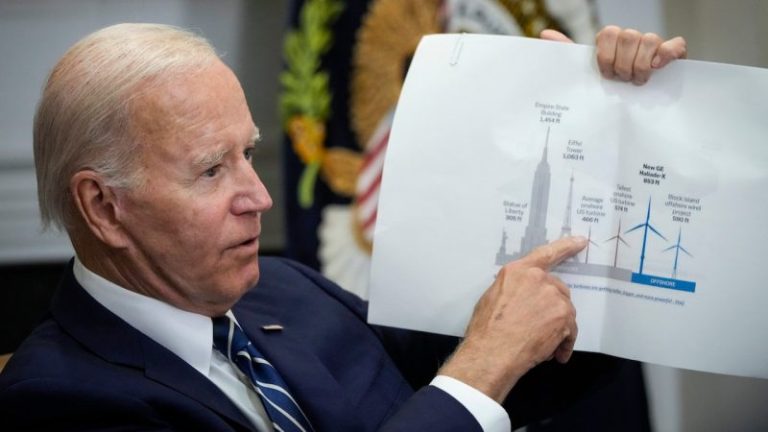05 July 2023 – President Biden can’t choose his direct opponent next year. But Mr. Biden and Democrats can certainly manufacture one.
The Supreme Court is on the ballot in 2024.
Liberals are incensed at the latest spate of Supreme Court opinions. Several of the decisions went against causes important to the left.
The High Court undid the President’s plan to cancel $400 billion in student loans. LBGTQ groups are infuriated that the Court ruled that a Colorado web designer doesn’t have to make sites for same-sex weddings. Finally, the Supreme Court ruled against affirmative action requirements in higher education.
Expect Democrats to resort to a page in their playbook which likely helped the party gain a seat in the Senate and nearly cling to control in the House in 2022. The Dobbs opinion on abortion last year emerged as a game changer. It energized progressives and pro-choice Democrats and independents. The ruling infused the polls with a stream of voters, serving as a political life preserver to the party.
Democrats have a lot more to campaign on in 2024 when it comes to the Supreme Court. Questions about the ethics of Justices Samuel Alito and Clarence Thomas abound. U.S. Chief Justice John Roberts declined to take part in a hearing called in the spring by Senate Judiciary Committee Chairman Dick Durbin, D-Ill., about the conduct of the justices. The panel is prepping another clash with the Court as Senate Democrats write a bill about the ethics of justices.
Rep. Alexandria Ocasio-Cortez, D-N.Y., told CNN the justices are ‘destroying the legitimacy of the Court.’ She endorses issuing subpoenas for justices.
‘They are expanding their role into acting as though they are Congress itself. And that, I believe, is an expansion of power that we really must be focusing on the danger of this court and the abuse of power in this Court, particularly as it is related to the entanglements around conflicts of interest as well,’ said Ocasio-Cortez.
This is why left-wing Members hope to expand and potentially ‘pack’ the Court with jurists who may do the bidding of progressives.
‘Expanding the court is constitutional. Congress has done it before and Congress must do it again,’ said Sen. Ed Markey, D-Mass.
Markey is right. The composition of the Supreme Court has bounced around for decades. The size of the Court is not established by the Constitution. Congress set the makeup of the Court via statute. Congress would periodically increase or decrease the number of seats on the Court for political reasons.
The Judiciary Act of 1789 created a Supreme Court comprised of six justices. But in 1801, Congress reduced the size of the Court to five justices. That was an effort to undercut President Thomas Jefferson from filling the Supreme Court with one of his nominees. Don’t forget that the House of Representatives elected Jefferson as president in what is known as a ‘contingent election’ following a dispute over the Electoral College.
Because of the burgeoning size of the federal judiciary, Congress added a seventh justice to help oversee lower courts in 1807. The Court grew to nine justices in 1837.
In 1863, Congress added a 10th seat to the Supreme Court for President Lincoln. This came right after the pro-slavery Dred Scott decision in the late 1850s. There was hope that Lincoln could retool the Court following the Dred Scott case by appointing a jurist aligned with the Union who opposed slavery. However, Lincoln never filled that seat. But after Lincoln’s assassination, there was fear that President Andrew Johnson may alter the court. So in 1866, Congress shrunk the size of the Supreme Court to seven justices. That prevented Johnson from nominating anyone to the Supreme Court as the nation was in the midst of Reconstruction.
Once Johnson was out of office Congress switched the number back to nine for President Ulysses S. Grant. It’s remained at nine ever since.
But there have been efforts to change the Court’s composition since then.
President Franklin Delano Roosevelt tried to ‘pack’ the Court in 1937. He hoped to add justices for every member of the Supreme Court who was over the age of 70.
In a radio ‘Fireside Chat’ on March 9, 1937, FDR squarely challenged the High Court.
‘The Courts, however, have cast doubts on the ability of the elected Congress to protect us against catastrophe by meeting squarely our modern social and economic conditions,’ said Roosevelt.
FDR accused the Supreme Court of an ‘arbitrary exercise of judicial power’ when it came to opinions about banks and railroads. So the president hoped to change the Court by adding more youthful members who might align more closely with his political agenda.
‘There is nothing novel or radical about this idea,’ said FDR, noting that Congress also changed the Court’s membership in 1869. ‘It seeks to restore the Court to its rightful and historic place in our Constitutional government.’
But FDR failed to marshal enough support for the plan with his Fireside Chats. The public opposed the idea and the Senate Judiciary Committee emphatically torpedoed the plan.
It’s doubtful that the Democrats efforts to increase the size of the Supreme Court will go anywhere. It’s unclear that the proposal has anywhere close to 51 votes to pass in the Senate. Commandeering 60 votes to overcome a filibuster is even more daunting.
However, this gives liberals another chance to rail against Senate procedures and call for an end to the filibuster. It energizes the base and helps Democratic candidates raise money.
That’s why this effort is more about the ballot box in 2024.
‘If you want to motivate American voters, you need to scare them,’ said Catawba College political science professor Michael Bitzer.
Bitzer says that Democrats used last year’s abortion opinion ‘as a weapon in the campaign.’ It helped Democrats mitigate losses in the midterms.
Bitzer believes Democrats now have the opportunity to lean on three key voting blocs to help them in 2024. Democrats will lean on younger voters upset about student loans. There are minority voters upset about the Affirmative Action decision. Finally, Democrats will rely on the LBGTQ+ community.
However, the closing argument could be the composition of the Supreme Court itself.
‘Democrats will look at the Court and argue there are individuals that should not be on the Court and that they are on the Court and we have to play hardball,’ said Bitzer.
Dial back to February 2016.
Late Justice Antonin Scalia died unexpectedly. Former President Obama nominated current Attorney General Merrick Garland to fill his seat. Senate Minority Leader Mitch McConnell, R-Ky., is the Majority Leader at the time. He refuses to grant Garland a hearing. McConnell says the next president should fill that seat.
So former President Trump prevails in the 2016 presidential election and nominates Justice Neil Gorsuch. McConnell then shepherds Gorsuch’s nomination to confirmation after Democrats threatened a filibuster.
Upset by filibusters, Senate Democrats established a new precedent in the Senate in 2013 to short-circuit most filibusters of executive branch nominees, known as the ‘nuclear option.’ But they left in place the potential to filibuster a Supreme Court Justice. The Senate had never filibustered a Supreme Court nomination. However, the Senate did filibuster the promotion of late Justice Abe Fortas from Associate Justice to U.S. Chief Justice in the late 1960s.
Facing a filibuster, McConnell deployed the nuclear option to confirm Gorsuch. McConnell again relied on the nuclear option to confirm Justice Brett Kavanaugh in the fall of 2018.
After the death of Justice Ruth Bader Ginsburg, McConnell ignored what he said in 2016 about confirming justices in a presidential election year. The GOP-controlled Senate rammed through the confirmation of Justice Amy Coney Barrett days before the 2020 presidential election.
This is why liberals are apoplectic about the Supreme Court.
‘Republicans have been very willing to change the rules of the game,’ said Bitzer. ‘Democrats are slowly coming to the realization that if (Republicans) are going to play that game by their rules, then (they) need to be playing that game by (their) own set of rules.’
You can’t always pick your opponent in politics.
NBA teams often pine to secure a certain matchup in the playoffs. Team A pairs up really well against Team B. Then team A is often disappointed it didn’t get the opponent it ‘wanted.’
You can’t manufacture a potential adversary in sports. But you can in politics.
President Biden can’t choose his direct opponent in 2024. But Mr. Biden and Democrats can certainly aim to put the Supreme Court on the ballot in 2024.
Chad Pergram currently serves as a senior congressional correspondent for FOX News Channel (FNC). He joined the network in September 2007 and is based out of Washington, D.C.
This post appeared first on FOX NEWS










